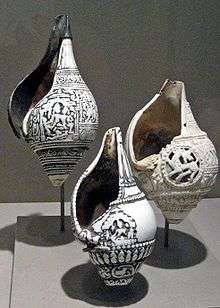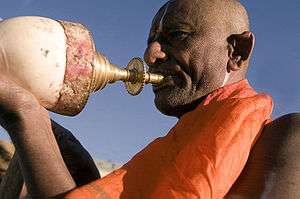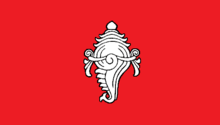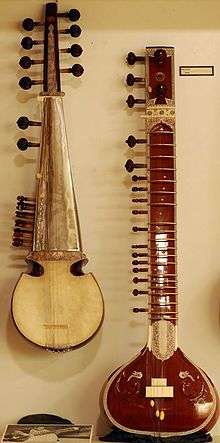Shankha


A Shankha is a conch shell of ritual and religious importance in Hinduism and Buddhism. It is the shell of a large predatory sea snail,Turbinella pyrum found in the Indian Ocean.
In Hindu mythology, the shankha is a sacred emblem of the Hindu preserver god Vishnu. It is still used as a trumpet in Hindu ritual, and in the past was used as a war trumpet. The shankha is praised in Hindu scriptures as a giver of fame, longevity and prosperity, the cleanser of sin and the abode of Lakshmi, who is the goddess of wealth and consort of Vishnu.
The shankha is displayed in Hindu art in association with Vishnu. As a symbol of water, it is associated with female fertility and serpents (Nāgas). The shankha is the state emblem of the Indian state of Kerala and was also the national emblems of the Indian princely state of Travancore, and the Kingdom of Cochin.
The shankha is one of the eight auspicious symbols of Buddhism, the Ashtamangala, and represents the pervasive sound of Buddhism.
A powder made from the shell material is used in ayurveda, primarily as a cure for stomach ailments and for increasing beauty and strength.
In the Western world, in the English language, the shell of this species is known as the "divine conch" or the "sacred chank". It may also be simply called a "chank" or conch. The more common form of this shell is known as "left-turning" in a religious context, although scientists would call it "dextral". A very rarely encountered form has reverse coiling which is called "right-turning" in a religious context, but is known as "sinistral" or left-coiling in a scientific context.
Characteristics
This shell is from a sea snail species Turbinella pyrum in the family Turbinellidae. This species is found living in the Indian Ocean and surrounding seas. The shell is porcelaneous (i.e. the surface of the shell is strong, hard, shiny, and somewhat translucent, like porcelain).
The overall shape of the main body of the shell is oblong or conical. In the oblong form, it has a protuberance in the middle, but tapers at each end. The upper portion (the siphonal canal) is corkscrew-shaped, while the lower end (the spire) is twisted and tapering. Its colour is dull, and the surface is hard, brittle and translucent. Like all snail shells, the interior is hollow. The inner surfaces of the shell are very shiny, but the outer surface exhibits high tuberculation.[1] In Hinduism, the shiny, white, soft shankha with pointed ends and heavy is the most sought after.[2]
Types
Based on its direction of coiling, the shankha has two varieties:[3][4]
Significance of the Dakshinavarta shankha
- A Dakshinavarti Shankh: This is the very rare sinistral form of the species, where the shell coils or whorls expand in a counterclockwise spiral if viewed from the apex of the shell.
- The Vamavarta ("left-turned" as viewed with the aperture uppermost): This is the very commonly occurring dextral form of the species, where the shell coils or whorls expand in a clockwise spiral when viewed from the apex of the shell. In Hinduism, a dakshinavarta shankha symbolizes infinite space and is associated with Vishnu. The Vamavarta shankha represents the reversal of the laws of nature and is linked with Shiva.[5]
The Dakshinavarta shankha is believed to be the abode of the wealth goddess Lakshmi - the consort of Vishnu, and hence this type of shankha is considered ideal for medicinal use. It is a very rare variety from the Indian Ocean. This type of shankha has three to seven ridges visible on the edge of the aperture and on the columella and has a special internal structure. The right spiral of this type reflects the motion of the planets. It is also compared with the hair whorls on the Buddha's head that spiral to the right. The long white curl between Buddha's eyebrows and the conch-like swirl of his navel are also akin to this shankha.[4][6]
The Varaha Purana tells that bathing with the Dakshinavarta shankha frees one from sin. Skanda Purana narrates that bathing Vishnu with this shankha grants freedom from sins of seven previous lives. A Dakshinavarta shankha is considered to be a rare "jewel" or ratna and is adorned with great virtues. It is also believed to grant longevity, fame and wealth proportional to its shine, whiteness and largeness. Even if such a shankha has a defect, mounting it in gold is believed to restore the virtues of the shankha.[2]
Uses

In its earliest references, shankha is mentioned as a trumpet and in this form it became an emblem of Vishnu. Simultaneously, it was used as a votive offering and as a charm to keep away the dangers of the sea. It was the earliest known sound-producing agency as manifestation of sound, and the other elements came later, hence it is regarded as the original of the elements. It is identified with the elements themselves.[7] [8]
To make a trumpet or wind instrument, one drills a hole near the tip of the apex of the shankha. When air is blown through this hole, it travels through the whorls of the shankha, producing a loud, sharp, shrill sound. This sound is the reason the shankha was used as a war trumpet, to summon helpers and friends. Shanka continued to be used in battles for a long time. The sound it produced was called shankanad.
Nowadays, the shankha is blown at the time of worship in Hindu temples and homes, especially in the ritual of the Hindu aarti, when light is offered to the deities. The shankha is also used to bathe images of deities, especially Vishnu, and for ritual purification. No hole is drilled for these purposes, though the aperture is cut clean or rarely the whorls are cut to represent five consecutive shells with five mouths.[9][10]
Shankha is used as a material for making bangles, bracelets and other objects.[9] Because of its aquatic origin and resemblance to the vulva, it has become an integral part of the Tantric rites. In view of this, its symbolism is also said to represent female fertility. Since water itself is a fertility symbol, shankha, which is an aquatic product, is recognised as symbolic of female fertility. In ancient Greece, shells, along with pearls, are mentioned as denoting sexual love and marriage, and also mother goddesses.[7]
Different magic and sorcery items are also closely connected with this trumpet. This type of device existed long before the Buddhist era.
Ayurveda
Shankha is used in Ayurveda medicinal formulations to treat many ailments. It is prepared as conch shell ash, known in Sanskrit as shankha bhasma, which is prepared by soaking the shell in lime juice and calcinating in covered crucibles, 10 to 12 times, and finally reducing it to powder ash.[1] Shankha bhasma contains calcium, iron and magnesium and is considered to possess antacid and digestive properties.[11]
A compound pill called shankavati is also prepared for use in dyspepsia. In this case, the procedure followed is to mix shankha bhasma with tamarind seed ash, five salts (panchlavana), asafoetida, ammonium chloride, pepper, carui, caraway, ginger, long pepper, purified mercury and aconite in specified proportions. It is then triturated in juices of lemon and made into a pill-mass.[1] It is prescribed for vata (wind/air) and pitta (bile) ailments, as well as for beauty and strength.[2]
Significance

The sound of the shankha symbolises the sacred Om sound. Vishnu holding the conch represents him as the god of sound. Brahma Vaivarta Purana declares that shankha is the residence of both Lakshmi and Vishnu, bathing by the waters led through a shankha is considered as like bathing with all holy waters at once. Sankha Sadma Purana declares that bathing an image of Vishnu with cow milk is as virtuous as performing a million yajnas (fire sacrifices), and bathing Vishnu with Ganges river water frees one from the cycle of births. It further says "while the mere sight of the conch (shankha) dispels all sins as the Sun dispels the fog, why talk of its worship?"[2] Padma Purana asserts the same effect of bathing Vishnu by Ganges water and milk and further adds doing so avoids evil, pouring water from a shankha on one's own head before a Vishnu image is equivalent to bathing in the pious Ganges river.[9]
In Buddhism, the conch shell has been incorporated as one of the eight auspicious symbols, also called Ashtamangala. The right-turning white conch shell (Tibetan: དུང་གྱས་འཁྱིལ, Wylie: dung gyas 'khyil ), represents the elegant, deep, melodious, interpenetrating and pervasive sound of Buddhism, which awakens disciples from the deep slumber of ignorance and urges them to accomplish their own welfare and the welfare of others.
Shankha was the Royal State Emblem of Travancore and also figured on the Royal Flag of the Jaffna kingdom. It is also the election symbol of the Indian political party Biju Janata Dal.
In Hindu iconography and art

Shankha is one of the main attributes of Vishnu. Vishnu's images, either in sitting or standing posture, show him holding the shankha usually in his left upper hand, while Sudarshana Chakra (chakra - discus), gada (mace) and padma (lotus flower) decorate his upper right, the lower left and lower right hands, respectively.[12]
Avatars of Vishnu like Matsya, Kurma, Varaha and Narasimha are also depicted holding the shankha, along with the other attributes of Vishnu. Krishna - avatar of Vishnu is described possessing a shankha called Panchajanya. Regional Vishnu forms like Jagannath and Vithoba may be also pictured holding the shankha. Besides Vishnu, other deities are also pictured holding the shankha. These include the sun god Surya, Indra - the king of heaven and god of rain[13] the war god Kartikeya,[14] the goddess Vaishnavi[15] and the warrior goddess Durga.[16] Similarly, Gaja Lakshmi statues show Lakshmi holding a shankha in the right hand and lotus on the other.[17]
Sometimes, the shankha of Vishnu is personified as Ayudhapurusha "weapon-man" in the sculpture and depicted as a man standing beside Vishnu or his avatars.[18] This subordinate figure is called the Shankhapurusha who is depicted holding a shankha in both the hands. Temple pillars, walls, gopuras (towers), basements and elsewhere in the temple, sculpted depictions of the shankha and chakra - the emblems of Vishnu - are seen.[19] The city of Puri also known as Shankha-kshetra is sometimes pictured as a shankha or conch in art with the Jagannath temple at its centre.[16]
Shaligrams are iconographic fossil stones particularly found in the Gandaki River in Nepal which are worshipped by Hindus as representative of Vishnu. The shaligrama - which has the marks of a shanka, chakra, gada and padma arranged in this particular order – is worshipped as Keshava. Twenty-four orders of the four symbols defined for Shaligrama are also followed in worship of images of Vishnu with different names. Out of these, besides Keshava the four names of images worshipped starting with Shankha on the upper hand, are: Madhusudanah, Damodara, Balarama and Vamana.[20][21]
In Hindu legend
A Hindu legend in the Brahma Vaivarta Purana recalls the creation of conchs: Shiva flung a trident towards the asuras, burning them instantaneously. Their ashes flew in the sea creating conchs.[2] Shankha is believed to be a brother of Lakshmi as both of them were born from the sea. A legend describes an asura named Shankhasura, who was killed by Vishnu's fish avatar, Matsya.[22]

In the Hindu epics of Ramayana and Mahabharata, the symbol of Shankha is widely adopted. In the Ramayana epic, Lakshmana, Bharata and Shatrughna are considered as part-incarnations of Sheshanaga, Sudarshana Chakra and Shankha, respectively, while Rama, their eldest brother, is considered as one of the ten Avatars of shri Vishnu.[23]
During the great Mahabharata war, Krishna, as the charioteer of the Pandava prince and a protagonist of the epic - Arjuna - resounds the Panchajanya to declare war. Panchajanya in Sanskrit means 'having control over the five classes of beings'.[10] All five Pandava brothers are described having their own shankhas. Yudhishthira, Bhima, Arjuna, Nakula and Sahadeva are described to possess shankhas named Ananta-Vijaya, Poundra-Khadga, Devadatta, Sughosha and Mani-pushpaka, respectively.[2]
Association with Nāgas
Because of the association of the shankha with water, nāgas are often named after the shankha. The list of Nāgas in the Mahabharata, the Harivamsha and the Bhagavat Purana includes names like Shankha, Mahashankha, Shankhapala and Shankachuda. The last two are also mentioned in the Buddhist Jataka Tales and the Jimutavahana.[24] A legend states that while using Shankha as part of meditative ritual, a sadhu blew his shankha in the forest of village Keoli and a snake crept out of it. The snake directed the sadhu that he should be worshipped as Nāga Devata (Serpent god) and since then it has been known as Shanku Naga. Similar legends are narrated at many other places in Kullu district in Himachal Pradesh.[25]
See also
References
- 1 2 3 Nadkarni, K. M. (1994). Dr. K. M. Nadkarni's Indian Materia medica. Turbinella Rapa; or Xanchus Pyrum or Gastropoda, Class: Molusca. Popular Prakashan. pp. 164–165. ISBN 81-7154-143-7. Retrieved 2009-12-21.
- 1 2 3 4 5 6 Aiyar V.AK. Symbolism In Hinduism. Chinmaya Mission. pp. 283–6. ISBN 978-81-7597-149-3.
- ↑ Mookerji, Bhudeb (1998). The wealth of Indian alchemy & its medicinal uses: being an... Shankh. 1. Sri Satguru. p. 195. ISBN 81-7030-580-2. Retrieved 2009-12-21.
- 1 2 Thottam, Dr. P.J. (2005). Modernising Ayurveda. Shankh. Sura Books. pp. 38–39. ISBN 81-7478-640-6. Retrieved 2009-12-21.
- ↑ Jansen p. 43
- ↑ "Sri Navaratna Museum of Natural Wonders". Retrieved 2009-12-21.
- 1 2 Krishna, Nanditha (1980). The art and iconography of Vishnu-Narayana. Shankh. D.B. Taraporevala. pp. 31, 36 and 39. Retrieved 2009-12-21.
- ↑ Nayak, B. U.; N. C. Ghosh; Shikaripur Ranganatha Rao (1992). New Trends in Indian Art and Archaeology. Shankha. Aditya Prakashan. pp. 512–513. ISBN 81-85689-12-1. Retrieved 2009-12-21.
- 1 2 3 Rajendralala Mitra (2006). Indo-aryans. 285-8. Read Books. ISBN 978-1-4067-2769-2.
- 1 2 Avtar, Ram (1983). Musical instruments of India: history and development. Shankh. Pankaj Publications. pp. 41, 42. Retrieved 2009-12-21.
- ↑ Lakshmi Chandra Mishra (2004). Scientific basis for Ayurvedic therapies. CRC Press. p. 96. ISBN 978-0-8493-1366-0.
- ↑ "Sacred Shankha (Conch Shell)". Retrieved 2009-12-21.
- ↑ Jansen pp. 66-7
- ↑ Jansen p. 126
- ↑ Jansen p. 131
- 1 2 Helle Bundgaard, Nordic Institute of Asian Studies (1999). Indian art worlds in contention. Routledge. pp. 183, 58. ISBN 978-0-7007-0986-1.
- ↑ Srivastava, R. P. Studies in Panjab sculpture. Shank. Lulu.com. pp. 40–42. ISBN 0-9793051-1-X. Retrieved 2009-12-21.
- ↑ Rao, p. 156
- ↑ Dallapiccola, Anna Libera; Anila Verghese (1998). Sculpture at Vijayanagara: iconography and style. Shankh. Manohar Publishers & Distributors for American Institute of Indian Studies. pp. 44, 58. ISBN 81-7304-232-2. Retrieved 2009-12-21.
- ↑ Debroy, Bibek; Dipavali Debroy. The Garuda Purana. Shalagrama. Lulu.com. p. 42. ISBN 0-9793051-1-X. Retrieved 2009-12-21.
- ↑ Rao pp.231-232
- ↑ B. A. Gupte (1994). Hindu holidays and ceremonials. Asian Educational Services. p. xx. ISBN 978-81-206-0953-2.
- ↑ Naidu, S. Shankar Raju; Kampar, Tulasīdāsa (1971). A comparative study of Kamba Ramayanam and Tulasi Ramayan. Shank. University of Madras. pp. 44,148. Retrieved 2009-12-21.
- ↑ Vogel, J. (2005). Indian Serpent Lore Or the Nagas in Hindu Legend and Art. Kessinger Publishing. pp. 215–16. ISBN 978-0-7661-9240-9.
- ↑ Handa, Omacanda (2004). Naga cults and traditions in the western Himalaya. Shankh. Indus Publishing. p. 200. ISBN 81-7387-161-2. Retrieved 2009-12-21.
Bibliography
- Anthology of World Music: The Music of Tibetan Buddhism. [Booklet notes by Peter Crossley-Holland.] [CD] Massachusetts: Rounder Select
- Ellingson, T. (1979). The Mandala of Sound: Concepts and Sound Structures in Tibetan Ritual Music. Ann Arbor, Michigan: UMI
- Hornell, James (1914). The sacred Chank of India: A monograph of the Indian Conch (Turbinella pyrum) - Online Book. The Superintendent, Government Press, Madras.
- Jansen, Eva Rudy (1993). The Book of Hindu Imagery: Gods, Manifestations and Their Meaning. Diever: Binkey Kok Publications. pp. 144–. ISBN 978-90-74597-07-4.
- Kumar, N (2004). Retrieved 11 April 2006 from The Conch Shell.
- Marcuse, S. (1975). Musical Instruments: A Comprehensive Dictionary. New York: Norton
- Miller, R. (n.d.). Music of Tibetan Buddhism.
- Music of Tibetan Buddhism
- Rao, T. A. Gopinatha (1985). Elements of Hindu iconography. Delhi: Motilal Banarsidass Publishers. ISBN 9780895817617. Retrieved 15 June 2016.
- Wylie, Turrell (n.d.). Central Asian arts. Encyclopædia Britannica Online. Retrieved June 15, 2016.
- Yeshe, R (2003). Tibetan-English Dharma Dictionary.
External links
| Wikimedia Commons has media related to Shankha. |
